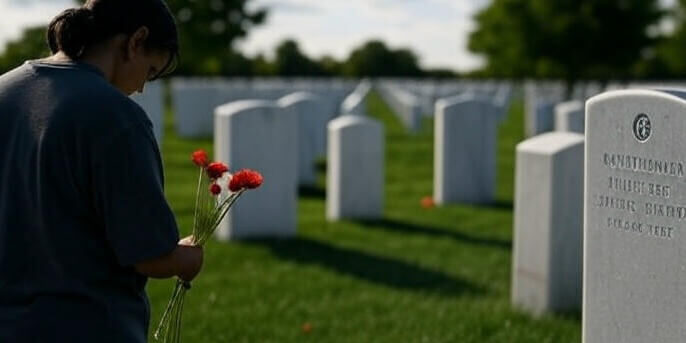Every Memorial Day, millions of Americans visit cemeteries. They place flowers on graves of fallen soldiers. This tradition goes back over 150 years. But where did it start? Why do we still do it today?
The Birth of Memorial Day
Memorial Day began after the Civil War ended in 1865. The war killed over 600,000 Americans. Families needed a way to honor their dead.
The first Memorial Day happened on May 30, 1868. Gen. John Logan led the Grand Army of the Republic. He chose this date because flowers bloomed across the nation. People could find fresh flowers to place on graves.
Mary Ann Williams from Columbus, Ohio, started visiting soldiers’ graves in 1866. She brought wildflowers from her garden. Other women joined her. Soon, entire communities gathered at cemeteries on the same day.
Why Flowers Matter
Flowers have special meaning when someone dies. They represent life, beauty, and rebirth. Ancient cultures used flowers in burial ceremonies. The tradition connects us to thousands of years of human history.
Different flowers carry different messages:
Red Poppies – These became the symbol of Memorial Day. The poem “In Flanders Fields” made them famous. John McCrae wrote it during WWI. He saw poppies growing on battlefields in Europe.
White Lilies – These flowers mean peace and hope. Many families choose them for Memorial Day.
American Flags with Flowers – This combination shows both patriotism and love.
 Personal Stories of Remembrance
Personal Stories of Remembrance
Linda Thompson from Texas has visited her brother’s grave every Memorial Day for 20 years. Her brother died in Iraq in 2004. She brings his favorite flowers – yellow roses.
“He gave me yellow roses on my birthday every year,” Linda shares. “Now I give them to him. It makes me feel close to him again.”
The Rodriguez family in California makes Memorial Day a family event. Three generations visit their grandfather’s grave together. He fought in WWII. The kids learn about his service while they place flowers.
“My granddaughter is only eight,” says Maria Rodriguez. “But she understands that flowers show love. She picks them out herself.”
The Spread of the Tradition
After 1868, Memorial Day spread across America. Northern states adopted it first. Southern states were slower to join. By 1890, most states observed Memorial Day.
Veterans groups helped spread the tradition. The American Legion formed in 1919. The VFW started in 1899. These groups organized cemetery visits. They taught people about Memorial Day’s meaning.
Facts About Memorial Day Flowers
- Americans spend $2.8 billion on flowers for Memorial Day each year
- Over 150 million flowers are sold the week before Memorial Day
- Red poppies became the official Memorial Day flower in 1922
- The tradition started 3 years after the Civil War ended
- All 50 states now observe Memorial Day as a legal holiday
- About 25 million veterans are buried in American cemeteries
Modern Memorial Day Traditions
Today’s Memorial Day looks different than 1868. But flowers remain central to the day. Families still gather at graves. They bring fresh flowers, wreaths, and small American flags.
Some cemeteries hold special ceremonies. Veterans groups give speeches. Military bands play music. Boy Scouts and Girl Scouts help place flags on veterans’ graves.
Technology changes how some people remember. Social media posts show flower-covered graves. Families far from cemeteries post virtual flowers online. But most people still prefer the real thing.
The Emotional Connection
Placing flowers creates a personal connection between the living and the dead. Dr. Sarah Chen, a grief counselor, explains why this matters.
“Flowers are a physical act of love,” Dr. Chen says. “People need to do something with their grief. Bringing flowers lets them express feelings they can’t put into words.”
James Parker lost his father in Vietnam when he was five years old. He’s now 60. He still brings flowers to his father’s grave every Memorial Day.
“I don’t remember much about him,” James admits. “But I remember his smile. The flowers are my way of saying ‘I still love you, Dad.'”
Different Types of Memorial Day Displays
Individual Graves – Single flowers or small bouquets placed by family members
Mass Displays – Large flower arrangements at memorial walls or monuments
Wreath Ceremonies – Formal events with speeches and military honors
Community Gardens – Some towns plant memorial gardens that bloom during Memorial Day
Keeping the Tradition Alive
Young people today still participate in Memorial Day flower traditions. Schools teach children about the holiday’s history. Scout groups visit cemeteries. Military families pass down the custom to their children.
Emma Wilson is 16. Her great-grandfather served in WWII. She volunteers to place flowers on unmarked veterans’ graves.
“Some soldiers don’t have family left,” Emma explains. “Everyone deserves flowers on Memorial Day. It’s the right thing to do.”
The Future of Memorial Day
Memorial Day will continue to evolve. But flowers will remain important. They connect us to the past. They honor sacrifice. They show respect.
As long as Americans value freedom, they will remember those who died for it. Flowers are a simple way to say “thank you” to people who can’t hear the words.
The tradition that started with Mary Ann Williams in Ohio continues today. Millions of Americans place flowers on graves each Memorial Day. They remember. They honor. They keep the tradition alive.
A Day of Remembrance
Memorial Day flowers represent more than decoration. They are symbols of love, respect, and gratitude. When families place flowers on graves, they participate in American history.
The flowers will fade. But the memory and meaning last forever. That’s the true power of this simple, beautiful tradition.








